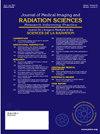Cultivating expertise in MRI physics in Mongolia through international collaboration
IF 1.3
Q3 RADIOLOGY, NUCLEAR MEDICINE & MEDICAL IMAGING
Journal of Medical Imaging and Radiation Sciences
Pub Date : 2025-04-16
DOI:10.1016/j.jmir.2025.101897
引用次数: 0
Abstract
Introduction
Mongolia's expanding MRI infrastructure faces challenges due to limited local MRI physics expertise, critical for optimizing scanner performance and ensuring diagnostic quality. In response, Intermed Hospital in Ulaanbaatar partnered with RAD-AID International to build MRI capacity and enhance imaging access across urban and rural areas.
Methods
This project included comprehensive MRI physics education, clinical protocol optimization, QA implementation, and the installation of two new MRI scanners. A didactic course covered MRI fundamentals, helping technologists, radiologists, and engineers understand how MRI parameters impact image quality. Practical sessions allowed staff to refine protocols to reduce artifacts, and an ACR-adapted QA program was established for consistent scanner monitoring.
Results
Participants demonstrated improved knowledge and practical skills, enabling them to independently adjust protocols and conduct QA. Two 1.5 T MRI scanners were successfully installed in Ulaanbaatar and Darkhan, with local staff applying new expertise to maintain consistent imaging quality.
Discussion
This collaborative model shows that partnerships with international experts can empower local teams in resource-limited settings to sustain high imaging standards, reduce reliance on external support, and enhance patient care through improved diagnostic quality.
Conclusion
The successful integration of MRI physics education, protocol optimization, and QA provides a replicable roadmap for similar low-resource settings, bridging healthcare gaps and expanding access to advanced imaging in underserved regions.
通过国际合作培养蒙古核磁共振物理专业人才
由于当地MRI物理专业知识有限,蒙古不断扩大的MRI基础设施面临挑战,这对于优化扫描仪性能和确保诊断质量至关重要。为此,乌兰巴托实习医院与RAD-AID国际合作,建设核磁共振成像能力,并加强城乡地区的成像获取。方法本项目包括全面的MRI物理教育、临床方案优化、QA实施和两台新的MRI扫描仪的安装。教学课程涵盖MRI基础知识,帮助技术人员、放射科医生和工程师了解MRI参数如何影响图像质量。实践会议允许工作人员改进协议以减少工件,并为一致的扫描仪监控建立了适应acr的QA程序。结果学员的知识水平和实践技能有所提高,能够独立调整方案和进行质量保证。两台1.5 T核磁共振扫描仪成功地安装在乌兰巴托和达尔汗,当地工作人员应用新的专业知识来保持一致的成像质量。这种合作模式表明,在资源有限的情况下,与国际专家的合作可以使当地团队保持高成像标准,减少对外部支持的依赖,并通过提高诊断质量来增强对患者的护理。结论MRI物理教育、方案优化和质量保证的成功整合为类似的低资源环境提供了可复制的路线图,弥合了医疗差距,扩大了服务不足地区先进成像的可及性。
本文章由计算机程序翻译,如有差异,请以英文原文为准。
求助全文
约1分钟内获得全文
求助全文
来源期刊

Journal of Medical Imaging and Radiation Sciences
RADIOLOGY, NUCLEAR MEDICINE & MEDICAL IMAGING-
CiteScore
2.30
自引率
11.10%
发文量
231
审稿时长
53 days
期刊介绍:
Journal of Medical Imaging and Radiation Sciences is the official peer-reviewed journal of the Canadian Association of Medical Radiation Technologists. This journal is published four times a year and is circulated to approximately 11,000 medical radiation technologists, libraries and radiology departments throughout Canada, the United States and overseas. The Journal publishes articles on recent research, new technology and techniques, professional practices, technologists viewpoints as well as relevant book reviews.
 求助内容:
求助内容: 应助结果提醒方式:
应助结果提醒方式:


